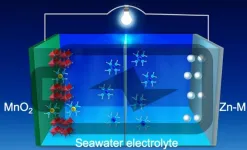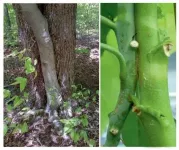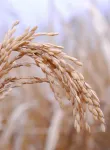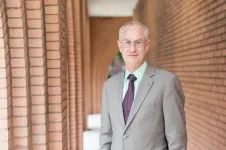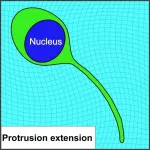(Press-News.org) CORVALLIS, Ore. - Researchers in the Oregon State University College of Engineering have developed a battery anode based on a new nanostructured alloy that could revolutionize the way energy storage devices are designed and manufactured.
The zinc- and manganese-based alloy further opens the door to replacing solvents commonly used in battery electrolytes with something much safer and inexpensive, as well as abundant: seawater.
Findings were published today in Nature Communications.
"The world's energy needs are increasing, but the development of next-generation electrochemical energy storage systems with high energy density and long cycling life remains technically challenging," said Zhenxing Feng, a chemical engineering researcher at OSU. "Aqueous batteries, which use water-based conducting solutions as the electrolytes, are an emerging and much safer alternative to lithium-ion batteries. But the energy density of aqueous systems has been comparatively low, and also the water will react with the lithium, which has further hindered aqueous batteries' widespread use."
A battery stores power in the form of chemical energy and through reactions converts it to the electrical energy needed to power vehicles, cellphones, laptops and many other devices and machines. A battery consists of two terminals - the anode and cathode, typically made of different materials - as well as a separator and electrolyte, a chemical medium that allows for the flow of electrical charge.
In a lithium-ion battery, as its name suggests, a charge is carried via lithium ions as they move through the electrolyte from the anode to the cathode during discharge, and back again during recharging.
"Electrolytes in lithium-ion batteries are commonly dissolved in organic solvents, which are flammable and often decompose at high operation voltages," Feng said. "Thus there are obviously safety concerns, including with lithium dendrite growth at the electrode-electrolyte interface; that can cause a short between the electrodes."
Dendrites resemble tiny trees growing inside a lithium-ion battery and can pierce the separator like thistles growing through cracks in a driveway; the result is unwanted and sometimes unsafe chemical reactions.
Combustion incidents involving lithium-ion batteries in recent years include a blaze on a parked Boeing 787 jet in 2013, explosions in Galaxy Note 7 smartphones in 2016 and Tesla Model S fires in 2019.
Aqueous batteries are a promising alternative for safe and scalable energy storage, Feng said. Aqueous electrolytes are cost-competitive, environmentally benign, capable of fast charging and high power densities and highly tolerant of mishandling.
Their large-scale use, however, has been hindered by a limited output voltage and low energy density (batteries with a higher energy density can store larger amounts of energy, while batteries with a higher power density can release large amounts of energy more quickly).
But researchers at Oregon State, the University of Central Florida and the University of Houston have designed an anode made up of a three-dimensional "zinc-M alloy" as the battery anode - where M refers to manganese and other metals.
"The use of the alloy with its special nanostructure not only suppresses dendrite formation by controlling the surface reaction thermodynamics and the reaction kinetics, it also demonstrates super-high stability over thousands of cycles under harsh electrochemical conditions," Feng said. "The use of zinc can transfer twice as many charges than lithium, thus improving the energy density of the battery.
"We also tested our aqueous battery using seawater, instead of high purity deionized water, as the electrolyte," he added. "Our work shows the commercial potential for large-scale manufacturing of these batteries."
Feng and Ph.D. student Maoyu Wang used X-ray absorption spectroscopy and imaging to track the atomic and chemical changes of the anode in different operation stages, which confirmed how the 3D alloy was functioning in the battery.
"Our theoretical and experimental studies proved that the 3D alloy anode has unprecedented interfacial stability, achieved by a favorable diffusion channel of zinc on the alloy surface," Feng said. "The concept demonstrated in this collaborative work is likely to bring a paradigm shift in the design of high-performance alloy anodes for aqueous and non-aqueous batteries, revolutionizing the battery industry."
INFORMATION:
The National Science Foundation supported this research.
PULLMAN, Wash. - Biomarkers in human sperm have been identified that can indicate a propensity to father children with autism spectrum disorder. These biomarkers are epigenetic, meaning they involve changes to molecular factors that regulate genome activity such as gene expression independent of DNA sequence, and can be passed down to future generations.
In a study published in the journal Clinical Epigenetics on Jan. 7, researchers identified a set of genomic features, called DNA methylation regions, in sperm samples from men who were known to have autistic children. Then in a set of blind tests, the researchers were able to use the presence of these features to determine whether other men had fathered autistic children with 90% ...
New research shows people who pursue meaningful activities - things they enjoy doing - during lockdown feel more satisfied than those who simply keep themselves busy.
The study, published in PLOS ONE, shows you're better off doing what you love and adapting it to suit social distancing, like swapping your regular morning walk with friends for a zoom exercise session.
Simply increasing your level of activity by doing mindless busywork will leave you unsettled and unsatisfied.
Co-lead researcher Dr Lauren Saling from RMIT University in Melbourne, Australia said while novelty lockdown activities - like baking or painting - have their place, trying to continue what you enjoyed before lockdown can be more rewarding.
"Busyness might be distracting but it won't necessarily be fulfilling," ...
COVID-19 infections are once again rising at an alarming rate in San Francisco's Latinx community, predominantly among low-income essential workers, according to results of a massive community-based testing blitz conducted before and after the Thanksgiving holiday by Unidos En Salud -- a volunteer-led partnership between the Latino Task Force for COVID-19 (LTF), UC San Francisco , the Chan Zuckerberg Biohub (CZ Biohub), and the San Francisco Department of Public Health (SFDPH).
Unidos En Salud launched their "Healthy Holidays" initiative the weekend before Thanksgiving (Nov. 22-24) in San Francisco's Mission District, where they have been perfecting their community-based surveillance testing ...
The genetic material of plants, animals and humans is well protected in the nucleus of each cell and stores all the information that forms an organism. For example, information about the size or color of flowers, hair or fur is predefined here. In addition, cells contain small organelles that contain their own genetic material. These include chloroplasts in plants, which play a key role in photosynthesis, and mitochondria, which are found in all living organisms and represent the power plants of every cell. But is the genetic material actually permanently stored within one cell? No! As so far known, the genetic material can migrate from cell to cell and thus even be exchanged between different organisms. Researchers at the Max Planck Institute of Molecular Plant Physiology (MPI-MP) ...
We are fascinated by machines that can control cars, compose symphonies, or defeat people at chess, Go, or Jeopardy! While more progress is being made all the time in Artificial Intelligence (AI), some scientists and philosophers warn of the dangers of an uncontrollable superintelligent AI. Using theoretical calculations, an international team of researchers, including scientists from the Center for Humans and Machines at the Max Planck Institute for Human Development, shows that it would not be possible to control a superintelligent AI. The study was published in the Journal of Artificial Intelligence Research.
Suppose someone ...
When an accident occurs, the reactions of bystanders are important. Researchers have studied whether laypeople realise the severity of the situation when someone in their proximity begins to bleed, and whether they can estimate how much the person is bleeding. The results show a discrepancy related to the victim's gender: for a woman losing blood, both blood loss and life-threatening injuries were underestimated. The study has been published in the scientific journal PLoS One.
Researchers from Linköping University and Old Dominion University in the United States wanted to study the ability of laypeople to visually assess blood loss, and what influences them when judging the severity of an injury.
"Laypeople's ...
Recent years have provided substantial research displaying the effect of genetic mu-tations on the development of autism and other neurodevelopmental disorders. Based on those studies, researchers have focused attention on the commonalities be-hind those mutations and how they impact on the functioning of the brain. A study conducted by Professor Sagiv Shifman from the Life Sciences Institute at the He-brew University of Jerusalem and the Center for Autism Research has found that genes associated with autism tend to be involved in the regulation of other genes and to operate preferentially in three areas of the brain; the cortex, the striatum, and the cerebellum.
The cerebellum ...
Rice is the staple food of about half the world's population. The cultivation of the rice plant is very water-intensive and, according to the German aid organization Welthungerhilfe, around 15 per cent of rice is grown in areas with a high risk of drought. Global warming is therefore becoming increasingly problematic for rice cultivation, leading more and more often to small harvests and hunger crises. Crop failures caused by plant pathogens further aggravate the situation. Here, conventional agriculture is trying to counteract this with pesticides, which are mostly used as a precautionary measure in rice cultivation. The breeding of resistant plants is the only alternative to these environmentally harmful ...
Seeking to understand why COVID-19 is able to suppress the body's immune response, new research from the USC Leonard Davis School of Gerontology suggests that mitochondria are one of the first lines of defense against COVID-19 and identifies key differences in how SARS-CoV-2, the virus that causes COVID-19, interacts with mitochondrial genes when compared to other viruses.
These differences offer possible explanations as to why older adults and people with metabolic dysfunction have more severe responses to COVID-19 than other individuals, and they also provide a starting point for more targeted experiments that may help identify therapeutics, said senior author Pinchas Cohen, professor of gerontology, ...
Our bodies often dispatch stem cells to mend or replace biological damage, but how these repair agents make their way through dense tissue to arrive at the scene had been a mystery. "How stem cells squeeze through tissue openings a hundred to a thousand times smaller than themselves had been a perplexing question," says Ovijit Chaudhuri, professor of mechanical engineering.
In an article published in the Jan. 8 edition of Science Advances, Chaudhuri and colleagues reveal that stem cells use their nucleus - a large, stiff organelle within the cell - as a means of propulsion.
Their discovery was surprising because scientists had thought cells would have particular ...
